Just a couple years ago, a 450 Cross Country Bike Shootout would be pretty thin. For decades, the only manufactures making XC specific models were KTM and different versions of Husqvarna. There have always been the trail models, such as the CRF-Xs, the WR-Fs, and a KLX and RMX-Z here and there, but if you wanted a cross country race machine, you’d start with the motocross bike and modify it from there. But over the last few seasons, this category of bike has seen some positive growth with interest from Japanese manufacturers and some smaller European brands.

What is a cross country bike? There isn’t a firm definition, but we use the loose parameters of a closed course, competition-designed dirt bike without lights and with off-road specific features. It’s any bike that bridges the gap between track-only motocross machines and trail-only enduro models. These bikes are aimed at riders who compete in GNCCs, National Enduros, and Sprint Enduros on the East Coast and National Hare and Hound, WORCS, Big 6, and Grand Prix style racing on the West Coast. That means that the bikes have to be able to handle some tight, technical riding, some moderate trail, some wide open, fast trail, and some track riding. Whichever bike in the comparison does the most at the highest level will be the winner.

To test these five bikes, we hit a wide variety of terrain, but we’ll be the first to admit that because of our geographical location, muddy, snotty, rooty, forested trails were not included. We do know that most of the Midwest and East Coast riding is different than California and we did our best to keep that in mind while testing. Our first stop was Cahuilla Creek MX, but we stuck to mostly the trail system on the property. Because of its variety of terrain, many brands have used it as the location for their press intros, more specifically, cross country bike intros. There is everything from wide open GP track sections to first-gear, single track, and bit of rocks thrown in as well. Second, we took the bikes to sand track in an undisclosed location which is where some of the motocross pros train when it is super rainy, as well as off-road riders. Lastly, we hit Milestone MX to see how the bikes handle a relatively neutral motocross track (not too rough, a little rutty sometimes, not crazy jumps).
We also want to thank Moose Racing for supplying us with gear for all of our testers as well as USWE Sports for hooking all our riders up with hydration packs.
Video
For the quick and to-the-point version of the shootout, check out this video. It has the overall ranking and scores of each bike and all the riders notes and opinions distilled down to the essence of each cross country machine. For much, much more detail, continue reading.
The Contenders
2019 Honda CRF450RX MSRP: $9,599 |
2019 Husqvarna FX 450 MSRP: $10,499 |
2019 KTM 450 XC-F MSRP: $10,599 |
2019 Sherco 450 SCF MSRP: $10,800 |
2019 Yamaha YZ450FX MSRP: $9,499 |

Bike Weights
We weighed all the bikes completely full of fuel, but we also subtracted the weight of the gas to give you a rough idea of the dry bike weight, using the approximation that gasoline weighs about 6 pounds, give or take depending on the temperature and atmospheric pressure.
| Bike | Total Wet Weight | Front Bias | Rear Bias | Approximate Dry Weight |
| Sherco 450 SCF | 267 lb | 127 lb (47.6%) | 140 lb (52.4%) | 251.6 lb (15.4 lb of gas) |
| Honda CRF450RX | 257 lb | 126 lb (49%) | 131 lb (51%) | 243.5 lb (13.5 lb of gas) |
| Yamaha YZ450FX | 256 lb | 122 lb (47.7%) | 134 lb (52.3%) | 242.8 lb (13.2 lb of gas) |
| KTM 450 XC-F | 238 lb | 115 lb (48.3%) | 123 lb (51.7%) | 223.6 lb (14.4 lb of gas) |
| Husqvarna FX 450 | 238 lb | 115 lb (48.3%) | 123 lb (51.7%) | 223.6 lb (14.4 lb of gas) |

The Results
1. KTM 450 XC-F: 10 Points
2-1-3-2-1-1
2. Yamaha YZ450FX: 13 Points
1-4-2-1-3-2
3. Husqvarna FX 450: 16 Points
3-2-1-4-2-4
4. Honda CRF450RX: 20 Points
4-3-4-3-3-3
5. Sherco 450 SCF: 30 Points
5-5-5-5-5-5
Testers
Michael Lindsay Age: 26 Height: 5'8" / Weight 158 lb Riding Experience: Somewhere between really good and really bad Recent Bikes: Everything Vital MX tests |
Sean Klinger Age: 32 Height: 5'9" / Weight 215 lb Riding Experience: Vet Novice (lots of experience, just not super fast) Recent Bikes: All of them |
Chris Hay Age: 36 Height: 5'9" / Weight: 160 lb Riding Experience: 30+ Pro Recent Bikes: 2018 Kawasaki KX450F, 2017 Yamaha YZ450F, 2012 RM-Z450 |
Chris Siebenhaar Age: 33 Height: 5'10" / Weight: 175 Riding Experience: Intermediate Recent Bikes: 2019 KTM 350 XC-F |
Scot Gustafson Age: 54 Height: 5'10" / Weight: 170 lb Riding Experience: 45 years Recent Bikes: 2019 Suzuki RM-Z450, 2019 Honda CRF450R |
Mystery Guest Tester Age: 22 Height: 5'7" / Weight: 120 lb Riding Experience: Novice Recent Bikes: Beta 430 RR-S, Beta 390 RR-S, KTM 500 EXC-F, Husqvarna FE 450, Honda CRF450L |
1. KTM 450 XC-F
Michal Lindsay’s Take
The chassis feels like a well sharpened knife; slicing from section-to-section, over rocks, through sand, and in even in loose or wet conditions. The ergos and chassis are the bright side of the KTM but the engine and suspension left me wanting a bit more.

The suspension side definitely leans towards chatter chop, taking on rocks and roots, and other smaller hits from more of a trail or enduro point of view. I find the KTM a bit difficult to push on a motocross track or a GP loop however, as the forks don't have enough hold up under braking or when just riding over the front of the bike aggressively. Bumping up the PSI helps a bit and some further clicker changes, but I found the further I went that way the more I lost the initial comfort and got the "dead" feeling from the AER fork that wasn't complimentary to the chassis. Out back though, I find the shock to be fantastic in off-road; nailing a great mix of initial comfort and recovery for small chop under acceleration, along with a enough hold up to be wheelied into rollers and other faster paced section.
Map one is my preferred setting, although it's more mellow than map two to the point where the power rolls on feels more usable. Map two has more bark but it comes on a bit later and just isn't as usable as I'd like in most cases. However, it was great on a sand track we hit, where the explosive feel could be well timed to correct and turn the bike with the rear. The traction control setting is also usable in tighter sections and in areas with low grip, such as wet, hard packed sections and slick rocks. The Brembo brakes are on point but the hydraulic clutch is too on-off for my liking it off-road. It feels like a light switch instead of a gradient to modulate power.
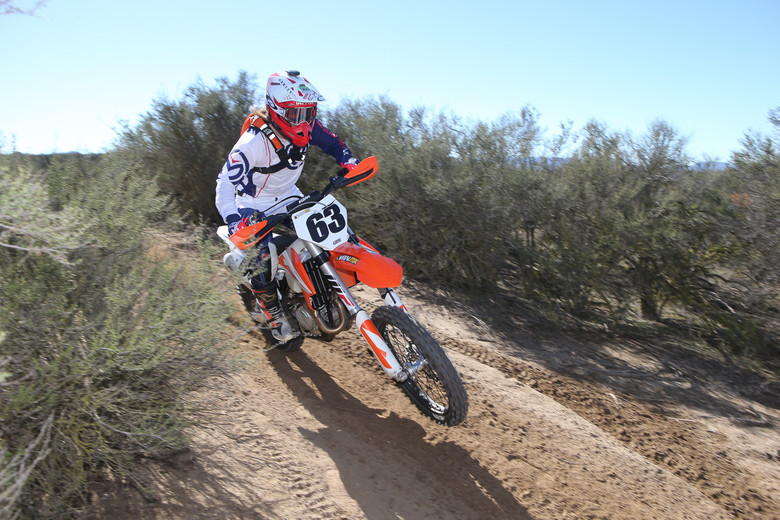
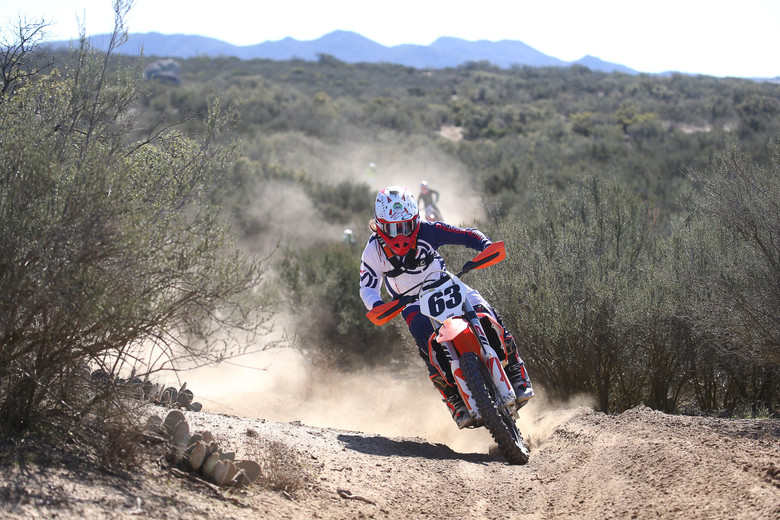
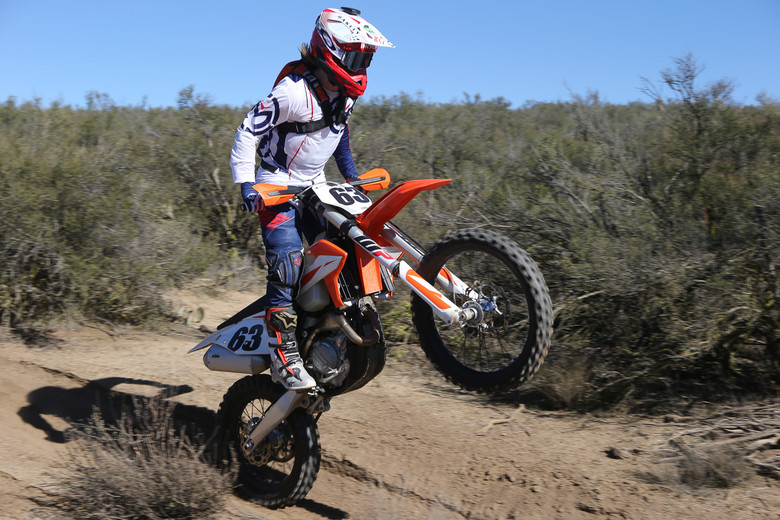
Sean Klinger’s Take
Looking at everything that a cross country bike should be able to do, I felt that the KTM was the most well rounded of all the bikes and could make the widest variety of riders happy. It didn’t make the top of the list for me in any specific department, but when you put it all together, it doesn’t really do anything wrong.
The motor has a more linear feel than the SX-F version of the bike which I liked. Rather than a smooth, mellow bottom end that ramps up to strong mid and crazy top-end, the XC-F feels like it has a little more power down low, and a little less up top. You could still rev the piss out of it and sort of ride it like a 250F if you wanted, especially in map 2 which shifts the meat of the power higher-up, more like the moto bike. Map 1 has more bottom end and signs off quicker. I liked map 2 for most of the off-road riding that we did because in the tight single track, it was easy to control, and as the trail opened up I could just get more aggressive with the throttle and the KTM would keep making good power. On the moto track, I liked map 1 since I wanted more bottom coming out of corners and to hit jumps in a lower gear.

The suspension does everything good, but doesn’t blow me away. That being said I wasn’t struggling with it by any means and was pretty happy with the way it worked across the board. The shock performed well in super slow, rocky terrain, faster trails, and on the motocross track. The only suspension in the test that I think was better overall was the YZ450FX’s.
Handling is where the KTM sort of pulls it all together and shines as an all-around winner. For a 450, it feels pretty nimble and light in the tight stuff and easy to get it through repeated S-turns, and it is also very comfortable going flatout in wide open terrain. It isn’t the most stable bike, but it recovers so quickly that it’s almost like it didn’t get out of shape to begin with. Also, it just feels so light and maneuverable for a 450, and that feel combined with the slimness of the bike makes the XC-F handle like a 125
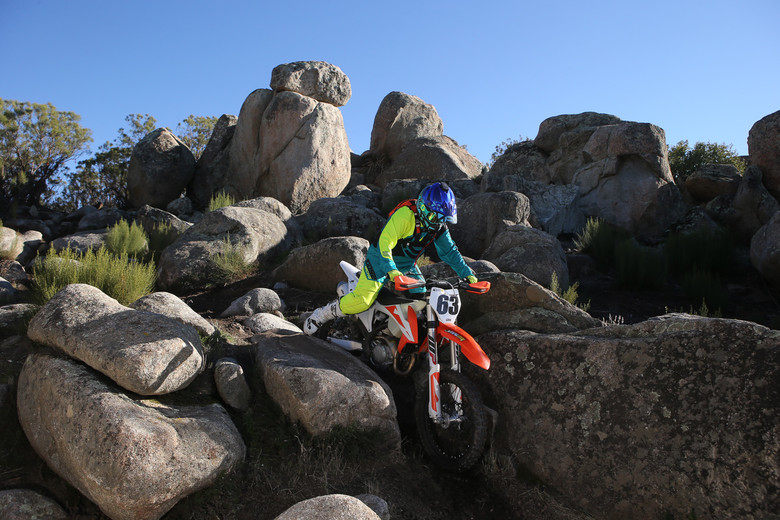

Chris Hay’s Take
If I had to say, in short, what the KTM felt like it would be “Easy to ride.” Straight away on the trails the KTM stood out to be incredibly easy to ride and no doubt it’s GNCC roots were noticeable. Power was strong yet easy to manage and not get into trouble with. Suspension was compliant on the trails and worked really well on higher speed, whooped-out straights, also on the tighter sections it was plush and comfortable.Taking the KTM onto the track it also performed well and actually some of it’s traits to me were better than I expected. I did feel that when I pushed the bike harder it was a little soft and that did hold me back from some of the things I really wanted to do but no doubt with a little set up time this could really challenge for my top spot.

Chris Siebenhaar’s Take
The 450 XC-F was almost my winner, and to be honest, I had a rough time placing it second. This bike checks all the necessary boxes; it has a powerful engine, excellent brakes, comfortable ergonomics, good handling and beautiful styling. In the braking department, the KTM’s Brembo front and rear brakes are by far my favorite, especially the front. There is an endless amount of power at the brake lever, but not just power, but ability to modulate the brake to perfection.
With a smooth, linear, and potent engine, the KTM is very easy to ride at any pace and for extended periods of time. This is not a hard hitting, punchy, knock your socks off type of engine like the Honda. The KTM builds is power with a slight nudge that transitions into a heavy push that has somehow pulled your socks off without you even knowing.

Although all the bikes have multiple maps, the KTM and Husqvarna are the only ones that feature Traction Control. Of all the elements that I tried the TC system in, I liked using it off-road the best. The system did not feel too invasive while riding on the trail, and I especially liked it while trying to wheelie off granite rocks as it kept the rear wheel from spinning too much and sweeping the bike sideways. On the track the TC system did seem to choke the bike down a little, most notably when trying to build a fast run out of a corner to clear a jump.
Scott Gustafson’s Take
The first thing I noticed about the new bike was the low seat height and slim chassis. Bar bend and ergonomics are neutral so the bike is easy to adopt to and gives you no surprises. I like the Brembo hydraulic clutch for it's easy pull. Now, putting the bike in gear first thing in the morning doesn't produce the dreaded drag of years gone by when the hydraulic clutch would cause a stall until things warmed up. The XC started easily in gear after a stall or tip over.
I have never been a fan of air forks but the AER fork on the new KTM is good. As a motorcycle tuner, I find air forks achilles heal is hard pack and this is where the KTM suspension shines. Overall, I found the suspension to be the best in class. I set the sag at 105mm on the prescribed mark on the rear fender and the chassis had good balance. Being the lightest bike is another big reason the KTM is easy to handle and maneuver. The tall ground clearance was also a benefit as I was able to deal with ruts, especially when my rusty skills took over. Cornering was not as good as the razor sharp Honda but was a good balance as the bike was stable at speed. A good tuning tip for KTM SX-F owners of mortal ability is to revalve their fork with XC valving specs.

The handlebar ignition switch has two modes I would call "strong and stronger". While I didn't have much preference between the two, I did prefer to keep the Traction Control mode on to lessen wheel spin. The engine doesn't produce the arm ripping power of the Honda but it does have more than enough while still remaining easy to control. The close ratio transmission worked well on our mostly flat test course especially the shift from 2nd to 3rd and back down.
Mystery Guest Tester
In the engine department, I found the KTM to be usable, playful, and predictable. Producing good, consistent power all the way through the revs the KTM allowed me to be consistent and smooth from one corner to the next. Compared to the rest of the field I noticed the KTM seemed to have a large amount of engine braking which made it difficult at times to roll through corners off the gas.
The WP AER 48mm fork and WP shock on the KTM offers a smooth ride for off-road conditions. Absorbing bumps and rocks with ease, the WP suspension feels great on the trail. Its supple characteristics allow the rider to manipulate the bike, putting the XC-F exactly where it needs to be. AER fork falls nicely into the stroke in a progressive manner while still offering good bottoming resistance. The only issue I found with the WP suspensions was in the faster, whoop sections where it seems to blow through the stroke a little fast and get bound up in itself. The XC-F’s agile chassis became apparent instantaneously when hopping on the trail. Its lightweight feel allowed me to become extremely comfortable on the bike. The combination of the supple WP suspension and the steel frame seemed to really compliment each other on the trail.
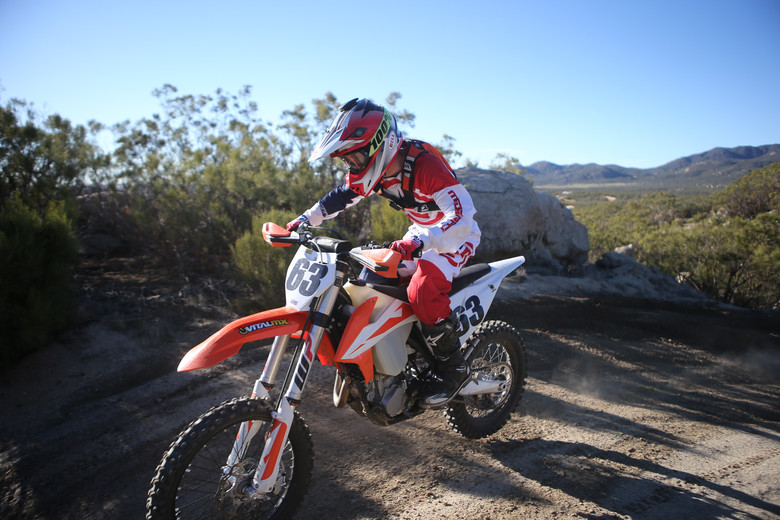
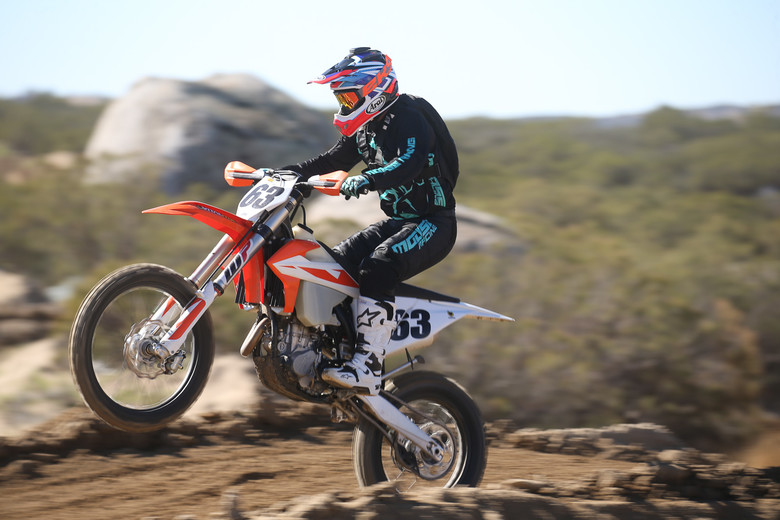
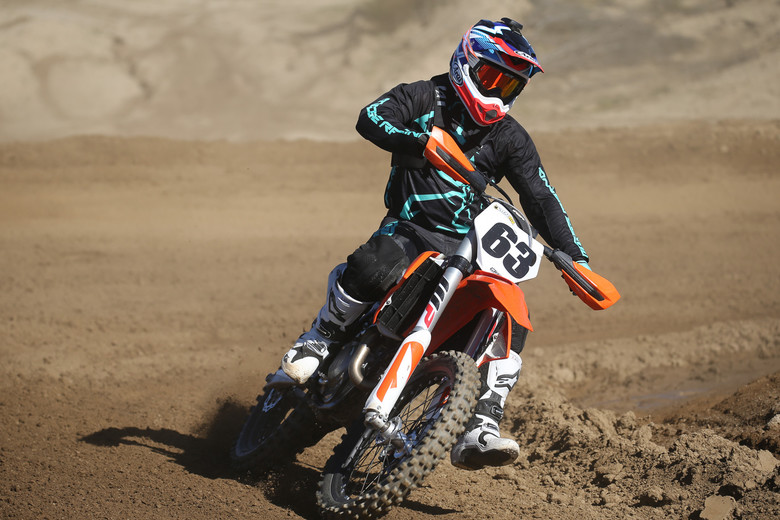
2. Yamaha YZ450FX
Michael Lindsay’s Take
While a few of the other machines in this test are better in certain categories over the YZ-FX, I personally feel that is is the only bike I'd enjoy to use in each one, which I can't quite say about the others in the test. So what makes the YZ450FX my top pick? It really starts at the chassis and suspension. The overall comfort from each combined was a great middle point between what I am looking for on the track, in high speed offroad and climbing over rocks. The FX's chassis has the same qualities of the moto bike with built in comfort that helps it take on square edge chop without violent reactions. Honestly, even when the front end does react poorly, the rest of the bike maintains its composure. Suspension-wise, the Yamaha is as good as Yamahas always are. For me, it hit the middle ground of what I needed on the track to feel confident pushing, the ability to soak up the high speed hits through sand rollers and other GP/desert style sections, and it has just enough comfort to creep through rocks without too much deflection.
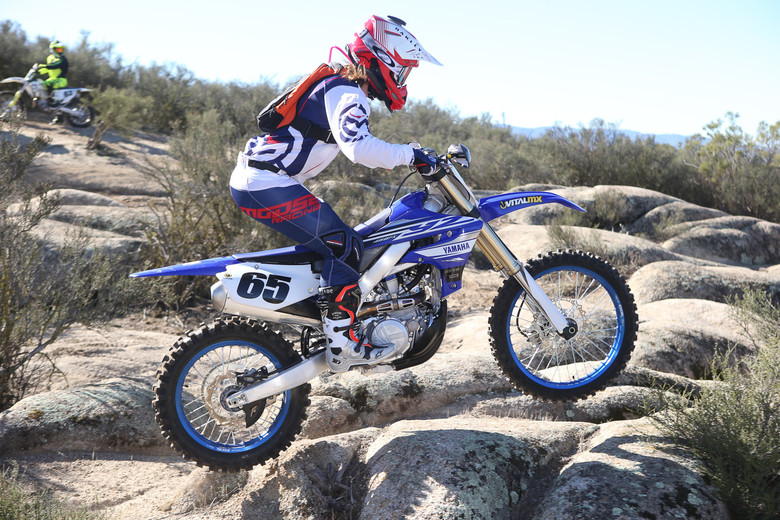
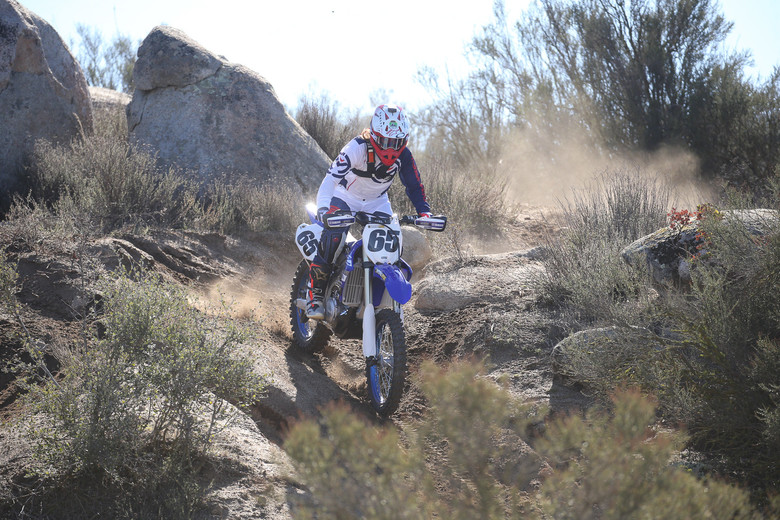
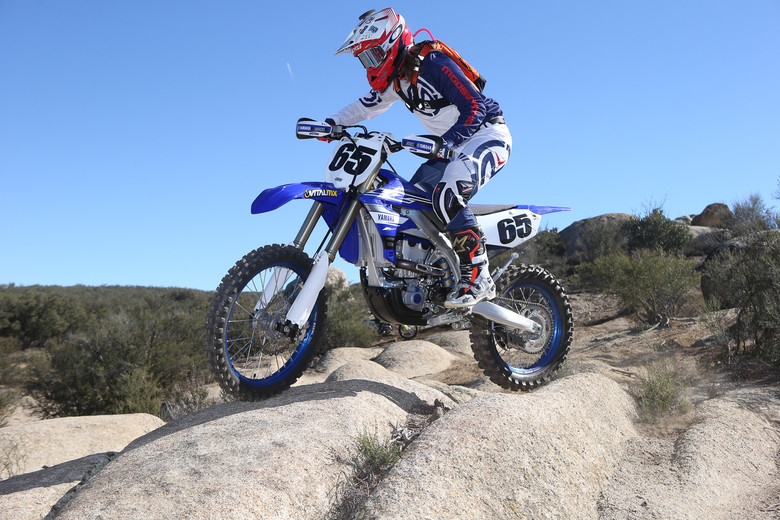
The engine side of things was a big positive as well. On a GP style circuit, it's easy to rear-steer when there's nothing to bank off of, lift over nasty chop, and hop into and out of corners. The Yamaha's tuner app makes it even better as I can richen up the bike for tighter areas on the second map, giving me a range of power for any situation. The YZ450FX is also the only bike in the class to have a wide-ratio transmission. I will admit it takes a minute to get used to when you've ridden almost all your time off-road on moto bikes but the FX's powerplant as enough output to make it work. This makes the FX the most enjoyable machine when things open up but it is still a blast in the tighter areas and on the track. It is actually really easy to ride on the track as you almost never have to shift! Really, at the end of it, here are my only complaints about the FX. I wish it came with an off-road tire, not the MX3S...I also wish the handlebar bend wasn't so tall. The FX really hits all the marks for me.
Sean Klinger’s Take
The motor, with the stock map, is a little different than the YZ450F and not really in a way that I liked. Look, I completely understand that for an off-road specific model, mellowing out the power to make it more manageable and controllable makes total sense. But it is hard, for those of use that have ridden the moto model so much, not to want that kind of power. The YZ-FX still has instant throttle response, and it revs very quickly, but it is missing a little of that meaty torque feeling that the YZ-F has. Again, good for off-road and I’m sure with the Power Tuner App you could dial in a map with more bottom end and aggressive hit. The stock map, though, is very linear and doesn’t really have a huge hit anywhere, which takes a little of the excitement away, but it isn’t slow by any means. The transmission is both a plus and a minus for me. For tighter to moderate trails, the five-speed, wide-ratio gear spacing worked pretty good. First gear is very low and I could see this saving the clutch in rock gardens and when picking your way up loose, techy hills. But the wide spacing makes it somewhat awkward to ride on the moto track.
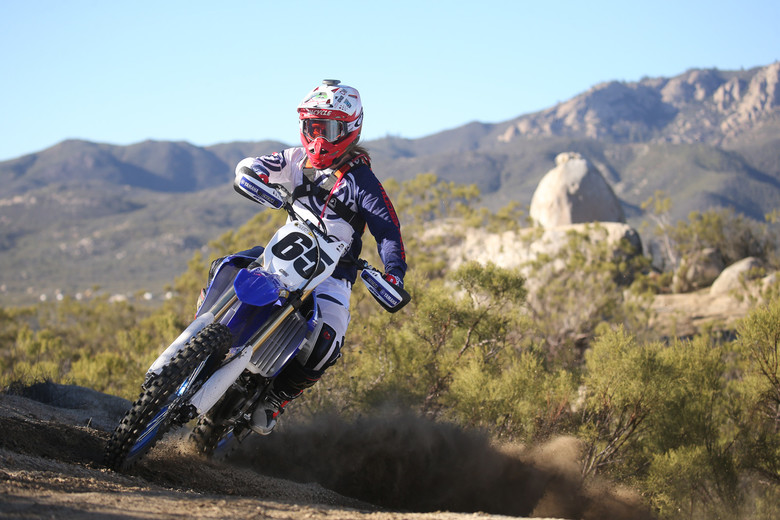
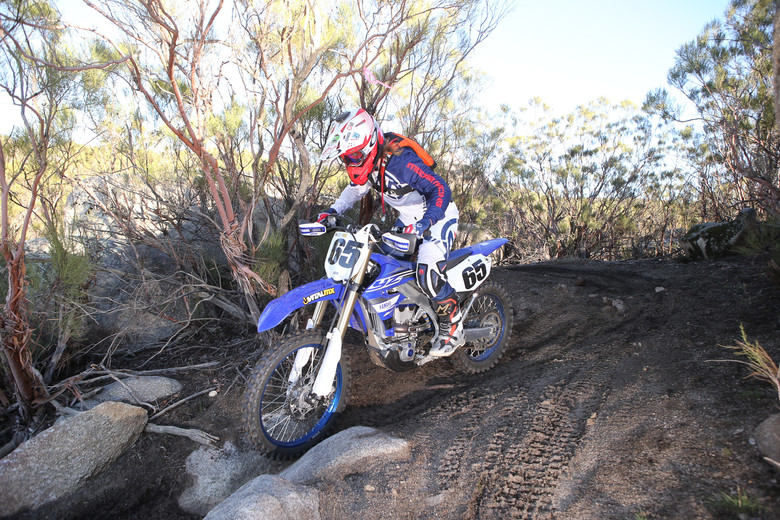
The YZ450FX’s suspension has the best balance of comfort and performance out of all the bikes. Buttery smooth and plush through any sort of chop or small chatter, and extremely composed on big hits. The YZ-F’s (moto bike) suspension is probably my favorite of all the moto bikes, and the only real difference on the FX is a softer initial feel, just at the beginning of the stroke.
The way the YZ450FX handles has a lot to do with chassis comfort and flex. Unlike the KTM, where the bike reacts but recovers quickly to off-camber hits or ledges, the Yamaha just doesn’t react at all. It’s like you feel the bike just soak them up and keep on going. At the sand track, I also noticed this great predictability when I would make a mistake and the front would push or wiggle around while falling into a rut, but from the steering stem rearward, the bike didn’t react at all.The bike tracked straight through the sand like it was completely ignoring the sloppiness I was creating with the front wheel. The YZ450FX feels a little big for tighter single track, especially in tight trees. It isn’t that is that bulky or hard to turn, just compared to some of the other bikes, it feels like it takes more effort to slice back and forth through repeated 90s.
Chris Hay’s Take
Off-road 50% - Motocross track 50%
If I could tie first and second in this shootout I would... The Yamaha felt like the positive changes from the motocross bike carried over to the off-road model. I really had a good time riding this bike and kinda felt myself keep coming back to it, since it was just that fun and enjoyable to ride on the track or the trails.

The Yamaha was really nimble and had a light feeling that reminded me of their motocross version with just a little more forgiving nature. Even on the rougher sections, dropping the front wheel into bumps didn’t cause a problem or a scary moment and took them all in its stride. Suspension was plush, yet firm enough to take some of the larger hits and landings on the motocross track also.
Even at the end of the day I could jump on and the bike inspired confidence to put fast laps down when conditions were at their roughest. The mapping adjustability was something that I liked, and both maps were suited to the conditions, a more mellow map for the trails and tight stuff then a more open aggressive map option for the motocross track. Overall, I had a great time riding the Yamaha and felt like it is a great option for anyone looking for a good all round bike for the track and trails equally.
Chris Siebenhaar's Take
The best way to describe the low end on the 450FX is that it feels like the bike is street legal, with what I can best describe as soft, airy, almost “choked up” feeling. Although the initial serving of power seems light, do not confuse that with a lack of power. The Yamaha has more than ample power to lift the wheel up, clear jumps on the track or simply gobble up straights like an Olympic sprinter.
Of all the bikes in the test, I struggled the most with the chassis on the Yamaha, which ultimately led to my 4th place decision. I had a lot of difficulty getting the bike to be where I wanted, especially on trails and rutted sections of the tracks. One of my biggest battles seemed to be when opening the throttle while in the turn, either to accelerate or simply to get to neutral throttle so I could settle the bike. In either situation, once the throttle was twisted, I found myself running wide, missing my exit, or simply just pushing the front end off the trail. Then there was the matter of getting the bike through the tight stuff. During our off-road loop and while just play riding, I found the Yamaha to fight me when trying to get around tight hairpin corners, or tight sections in general.

The highlight of the Yamaha package to me, is the suspension. It seemed like it was just at home anywhere we rode it. Slow and rocky trails? Suspension stays plush and soaks up the buzz. Fast GP tracks with rollers and ski-jumps? The bike soaks up the hits and stays very stable. MX style jumps? If you don’t case anything, you’re good. The range that the 450FX’s worked well in, was just simply incredible. By far my favorite suspension of the group. The other nice addition to the 450FX that no other model in the shootout can share, is the true wide-ratio transmission. Again, having raced this bike at a Glen Helen Big6 GP, with speeds ranging from a 1st gear rock canyon to a 5th tapped straight away, having wide-ratio transmission can be the difference between winning and being the first loser.
Scot Gustafson’s Take
The big Yamaha motor has 2 ignition modes that give a standard torquey motocross-type setting and a more of a traction setting. I found the standard setting to be very manageable in stock form. I know I would change and play with other settings because the Yamaha App allows so much tunability. The clutch never faded on our test bike but was the hardest to start in gear of all the bikes.
Yamaha's are a little thicker than other bikes but they take very little to get used to. I like the slimmer feel of the new bike compared to previous years bikes. The biggest downside in the chassis was the low ground clearance. I found myself lifting up my feet and dragging pegs in off-road ruts. To my surprise this did cause me some handling issues as I would slow up more than the other bikes on some obstacles. Flat corners poised no problems and the FX was by far the best performer in that area. The combination of the low center of gravity and torquey engine made the Yamaha the best bike on the motocross track too. I liked the low boy gas tank to handle the extra gas for off road. It reminded me of some Honda Works bikes from the 80's.
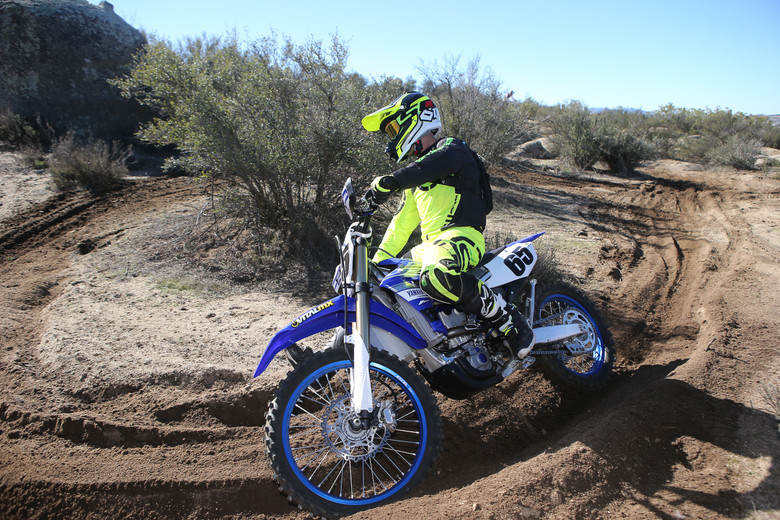
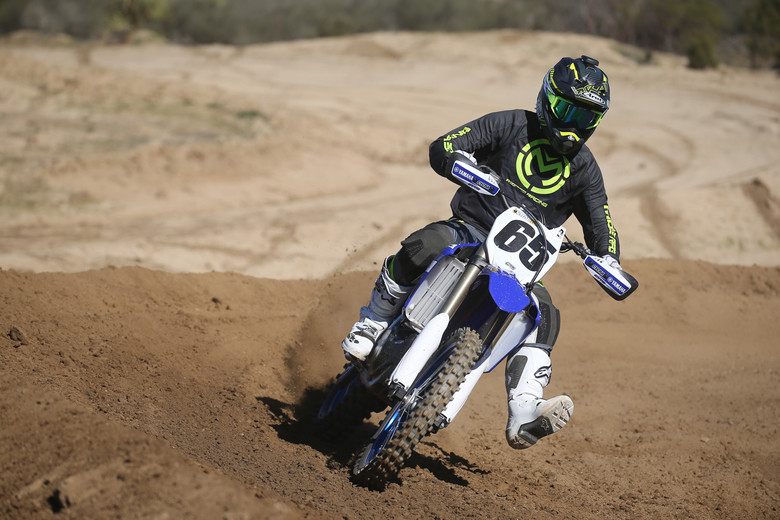
Mystery Guest Tester
The Yamaha YZ450FX has a great power plant that comes off the bottom smooth, predictable, and increasingly pulls harder through the revs in an extremely linear way. With two different map settings available with the touch of a button on the fly, the FX allowed me to adjust the power delivery from section to section as the trail changed from higher speeds to the tighter, more technical single trail. In addition, I found the FX has a good throttle response and delivery that never felt too touchy and hard to control or slow and unresponsive.
In the suspension department, I found the KYB fork and sock to be well balanced, plush, and progressive. In the high speed whoops the suspension took the hard hits extremely well, keeping the bike stable while simultaneously never feeling too harsh or stiff. As the trail became tighter and the speeds slowed down, I found the suspension did a good job falling into the stroke allowing the bike to feel plush and progressive, especially under hard braking.
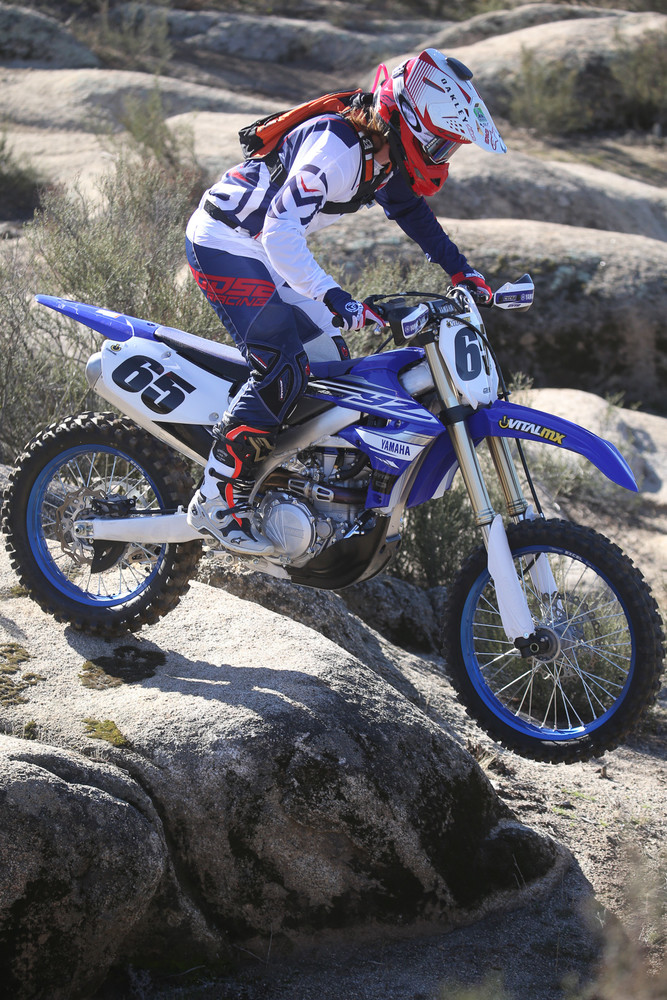

With the well-balanced suspension and a fairly rigid chassis, the FX allowed for a good mix of high-speed stability as well as good maneuverability. However, when sitting down in tight corners the FX felt a little tall and less willing to lean over but still provided good front end feel with plenty of feedback to the rider. Finally, the FX offered great stopping power with its 270mm rotor which provided a consistent feel and worked in sync with the KYB fork.
3. Husqvarna FX 450
Michael Lindsay’s Take
The FX 450 is comfortable and offers a lot of comfort in most situations. Whether creeping through the rocks and holding it pinned through some rollers, the chassis of the Husky is a good mix between confidence inspiring stability, but has enough "softness" to take the edge off. The Husqvarna's Magura clutch is the better of the two hydros in this test, as it offers more modulation and control of the power. However, the Magura brakes (yes, it has Magura brakes, not Brembo) are a bit soft and mushy overall. On moto tracks and GP sections with heavy braking zones, the front brake would just keep coming in towards the bars and didn't offer the confidence I'm used to on a Husqvarna.
The Husqvarna's FX 450's engine paces out a wide range of power but in a very mellow manner. This is a great package for trail riding, enduro conditions, GNCC, and even desert due to the wide powerband and semi-wide ratio transmission. However, the initial response of the engine is a bit lacking and I felt like I tended to over-throttle the bike at times, as I was trying to get the bike to come to life when I needed a little "oomph" to deal with an obstacle.

The suspension is at its best when it came to soaking up chop that would normally cause a lot of deflection, such as rocks, roots, and hard packed square edge. It offers a ton of comfort and feel in these situations and makes it so easy to stand or sit from the middle to back of the bike as the front created enough "feel" that I didn't need to be up on the tank. The fork doesn’t offer enough hold up and bottom quite easily. On the track it was honestly the softest in the test and while upping the air pressure helps, it begins to lose its initial comfort quite quickly.
Sean Klinger’s Take
I enjoyed riding this bike but it felt a little like eating my vegetables. Meaning, it is good for me but I don’t enjoy it as much as the three bikes ahead of it. Overall it doesn’t do anything bad, and riding it by itself would be fine, but riding it back to back with the KTM, I would rather ride the KTM.
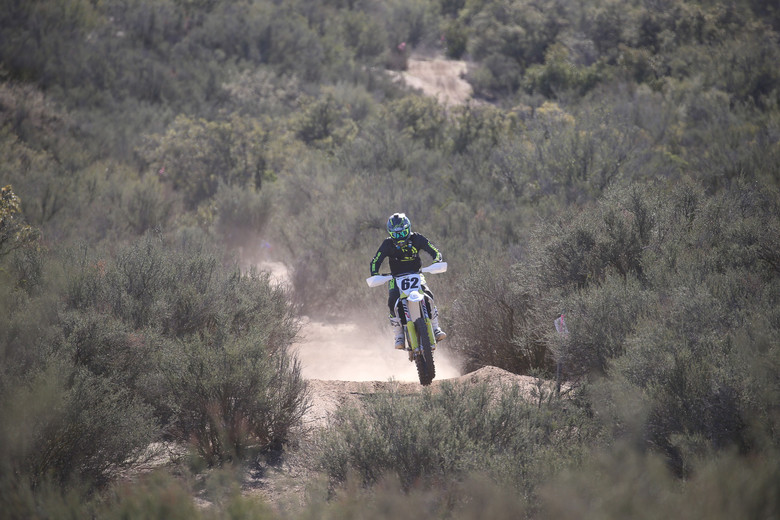
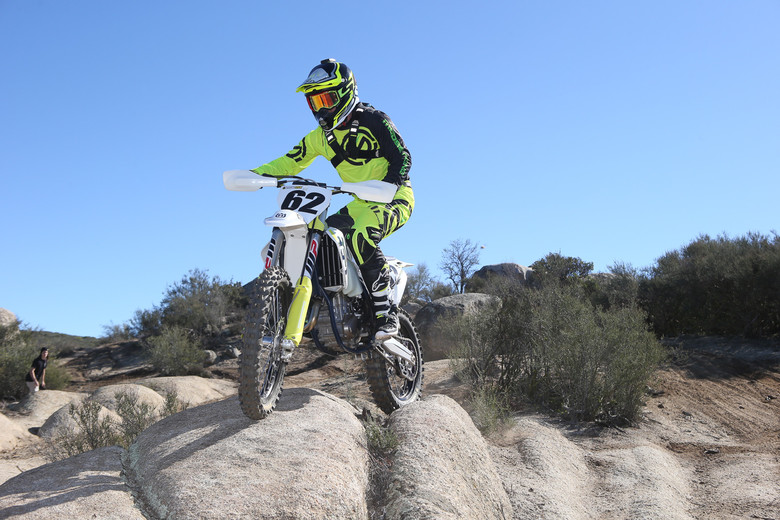
Starting with the motor, it is fast and still feels like a 450, but is mellower, in both maps, than the KTM and the Japanese bikes. On the plus side, where the KTM feels like it has a lot of engine braking, the FX 450 feels more free and didn’t pitch forward on deceleration nearly as much. The mellower power character also feels like I could ride it with less effort and more deliberately on the trails, which goes back to it being like health food rather than a pizza. I could most likely ride the FX 450 all day and feel fresher and be much more consistent in line choice and speed than on the other bikes.
In most moderate riding situations the suspension works great and I have confidence in the front and rear traction, but when the speeds go up like on a GP course or on the moto track, that’s when I notice a lot more fork dive and a lot of shock movement. For the average trail rider, I think it is actually a good, comfort-leaning setting and with some work it can be moved closer to the performance end of the spectrum, but in stock form, especially compared to the KTM, it is just the milder version, overall. The handling of the Husqvarna FX 450 is probably its best trait. It might even feel lighter and more agile than the KTM. The slim chassis makes it super easy to stand and stay standing and charge, even when things got a little sideways. This also translated into a nimble, agile feeling through tight single track riding.

Chris Hay’s Take
Off-road 60% - Motocross track 40%
Really, it was a close call for top position on this shootout but the Husky just tipped it for me with it getting top laptimes on both the days of the shootout on the off-road loop and also the motocross track! The Husqvarna did have some similarities to the KTM in the feel, lightness and ease to ride but it just seemed to be a little bit setup more to my liking or maybe just suited to my riding style? Either way the bike works well for me!
The chassis of the Husqvarna was forgiving yet firm enough to take the bigger hits at high speed and supple on the rocks and slower sections. The Pro Taper bars that come stock on the Husky just have a little more comfort and feel good straight away. On the motocross track I did feel that the suspension was a little soft on braking and harder landings. Overall the Husqvarna felt really good and topped lap times in all conditions.

Chris Siebenhaar’s Take
The Husqvarna has a lot of similar attributes to the KTM, but not exact. For example, the motor characteristics where similar in terms of power, but differed in how that power built up. The FE450 has a VERY free revving engine, almost as if it has a lighter flywheel. Because of this, the engine feels very lively and ready to jump out of every corner or loft the front wheel over anything that comes your way.
Chassis on the Husqvarna has more pep than a field mouse, and while I believe some of this feeling comes from the FE450’s suspension, most comes from the engine. Because the engine rev’s so freely, blipping the throttle between direction changes really helps to stand the bike up and transition left to right with ease. This was most noticeable at lower speeds, on trails and through single track where you can really toss the bike around as if it was a 125. On the GP track I felt the bike tracked straight and true.
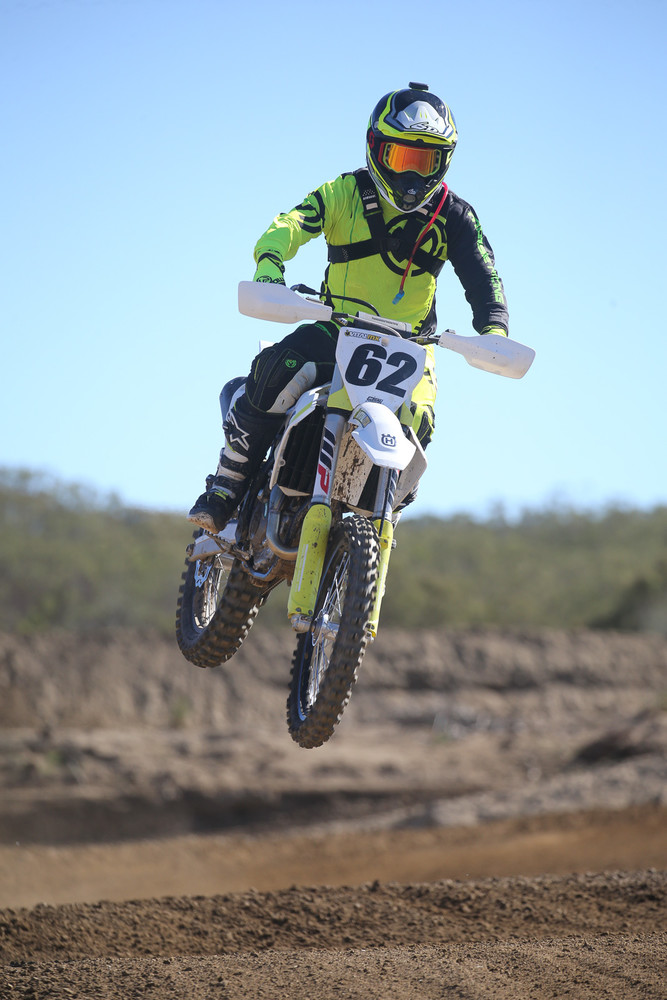
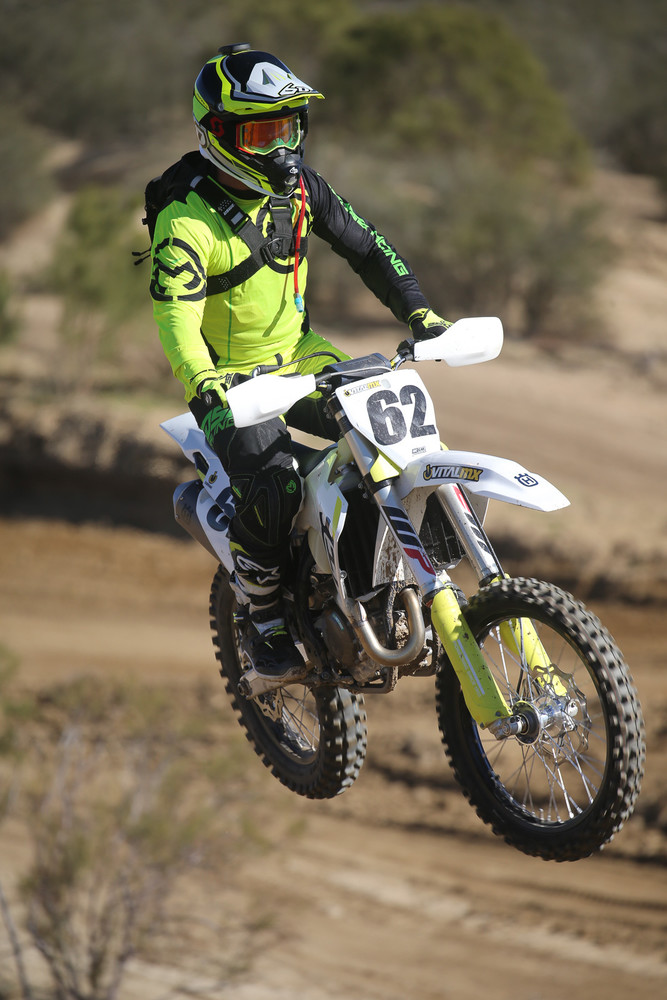

I found this bike to be the easiest to jump or skip through the roughest of sections, largely in part to its supple suspension and sprite engine. The suspension worked great through the rocks, tight sections and single track, but on the GP track is where the FX 450 starts to find its limit. Also, on the MX track the bike was definitely under sprung and under valved, even on the most modest jumps the bike would bottom out if you flat landed or even slightly came up short. In the brake department, the Magura unit on the Husqvarna leaves you with a love or hate feeling, depending on your riding ability and your pace. To cut to the chase, the brakes are pretty weak.
Scot Gustafson’s Take
The Husky has all the good attributes of the KTM. The low seat height and lightweight made it an easy bike to ride. One of the major difference between the Husky and KTM is the carbon fiber subframe. I felt that the subframe added width to the bodywork and had to deduct a point because I prefer the slimmer feel of the KTM. I'm also not a fan of having to remove a body panel in order to remove the seat. Another major difference between the Husky and KTM is the Magura clutch. The Magura clutch feels like a step down from the Brembo unit on the KTM. Under similar riding conditions, the Husky clutch smelt of burnt oil after riding on tight trails.


The motor on the Husky is solid. It produces good power that is manageable. Like the KTM, I had little preference on the ignition map but preferred to set the traction control mode for most conditions. The Husky is a beautiful bike when it is new but the funky white plastic looks a little substandard after it gets sand blasted and dragged across a few rocks. It's good to see the Swedish marque selling well in a tough market.
Mystery Guest Tester
Husqvarna’s engine in the FX 450 offers the rider an extremely usable and linear powerband. This makes the bike extremely easy to ride, however, at times in the faster sections or when you needed to pop the front wheel up suddenly the FX 450 left me wanting a little more punch between my legs. Compared to the KTM, the Husqvarna did not have the extremely noticeable engine braking that the XC-F had. This allowed for easier transitions from one corner to the next in the tight single track.
Again, similar to the KTM, the FX 450 shares the same WP AER 48mm fork and WP shock, however, I did notice the Husqvarna felt slightly softer than the KTM. This became slightly disappointing as the KTM’s suspension at times felt too soft. The Husqvarna’s suspension worked great in the tight, technical stuff. It wasn't until the faster, hard-hitting sections that the FX 450 felt too soft at speed, blowing through the stoke and not keeping a stable, planted feel.
Out of the five bikes, the Husqvarna offers the most playful chassis. Feeling light, nimble, and fairly flexible, the FX 450 is extremely easy to ride as well as super forgiving. As I weaved through the single trail, bouncing from one peg to the other, the Husqvarna felt extremely responsive. All around, the lack of punch in the motor and the soft suspension is what places it in third place for me.

4. Honda CRF450RX
Michael Lindsay’s Take
The RX has three maps to choose from; map one is well rounded but still has the surge of the moto bike, map two is the most off-road friendly as it's super smooth initially and continues to pull, map three is crisp and lurches coming out of corners - the type of power I'd want on the moto track but its reaction is just a bit too much to take off-road. The powerplant is very close to the moto bike overall, with big hit and a quick revving nature. Even in the smoothest map though, it can be a bit much when grip levels drop and not as easy as some other models to work in the tight areas. As for the transmission, it retains the exact ratios from the R model which keeps it feeling peppy and aggressive on the track and courses that don't require too much top speed. The transmission is at its best in third gear where the bike has great reaction and isn't as mellow as the other bikes with semi- and wide-ratio trannies. But, it doesn't have the overall range of usability as the other models in the test.
As for the chassis, the RX is precise! The amount of front end traction this bike puts out is pretty impressive and the harder you push it the more rewarding it is. On the downside, I felt that the Honda bit me the most of any bike in the test and was a bit unforgiving at times. In tight areas, at low speeds, this isn't too bad to recover from...but at high speed, it freaked me out a few times. Beyond that, I also feel the RX takes the most energy to ride due to the aggressive nature and the physical weight of the bike being more noticeable than some of the others on this list.
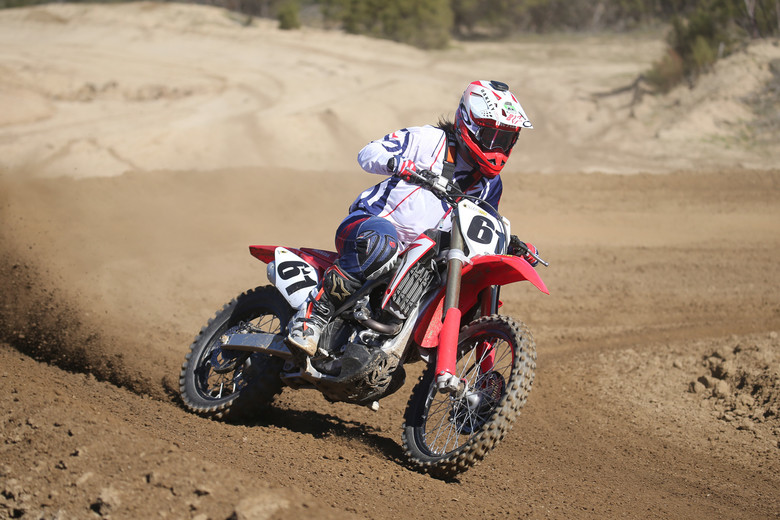
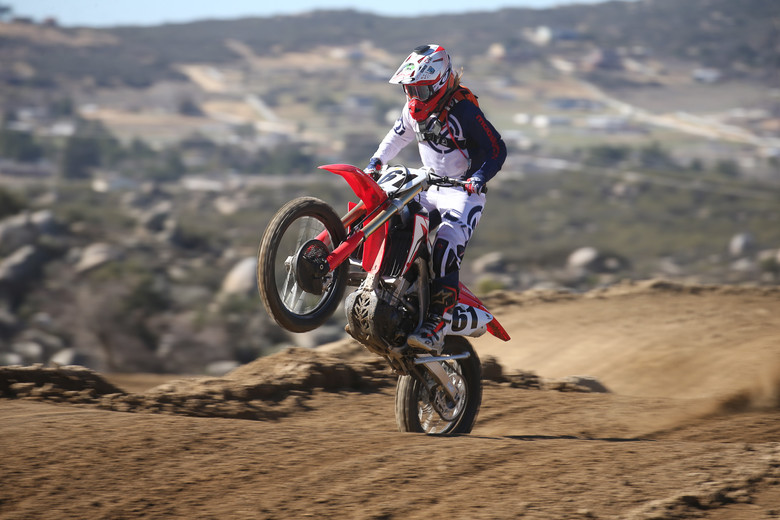
The suspension follows the same character as the rest of the bike; aggressive, fun to push, but not the most forgiving at times. The RX has the most hold up on the track and under heavy braking in off-road. It loves being thrown into deep rollers and pushing off banks at speed. However, it isn't the most comfortable in tight areas and on square edge chop, plus it has a tendency to deflect a bit in rocks.
Sean Klinger’s Take
Just like I said with the YZ, it sucks to place a bike third when it is as good as the Honda. This is by far the most aggressive motor in the test. If anything, it might rev a tiny bit slower than the YZ but has way more torque across the board, from the smallest crack of the throttle all the way to the top end. And if your thinking that explosive torque doesn’t work for off-road riding, there are three maps to choose from. I liked map 1 the most which is the most linear spread of power. Map 2 is mellowed-out and made getting traction and controlling the bike in tight trials much easier. Map 3 is the most aggressive and while some other guys liked it on the motocross track, I still preferred map 1 because it has the most torque on bottom.
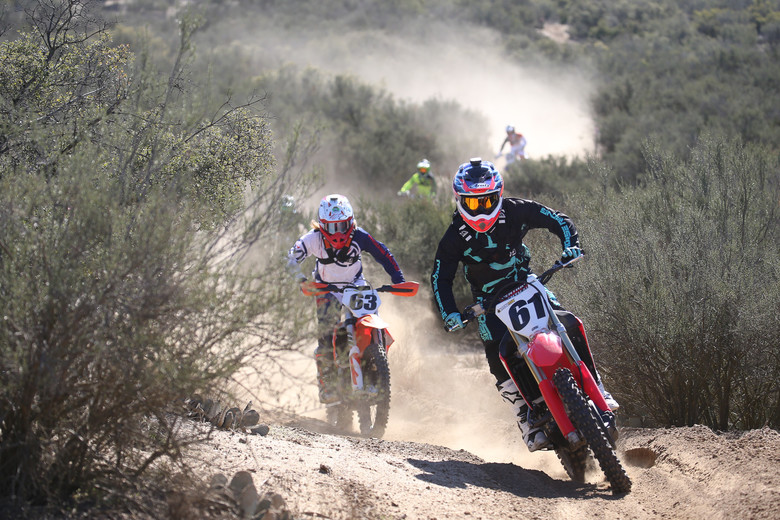

The suspension is also the most performance oriented/aggressive in the test. The harder you charge, the better it works. Both the fork and shock have a very active character, like you bounce up and over things really easy. I found it just plain fun to ride. It made me want to jump through rollers and whoops rather than leaning back and trying to pound through them. This also makes the CRF450RX feel light and playful. On the track, the suspension felt right at home while the other bikes were usable, but soft. But there is a downside to having stiffer suspension: very little comfort. I felt more beat up while riding the RX and the slower and rockier the trails got, the less fun I was having.
Handling wise, the RX retains a lot of the same stiff chassis feel that the R has, which is also good and bad. It makes it feel willing to turn very easily and change direction at the last second, yet it doesn’t have the most stable ride character. If I started to lose the front end, the whole bike would react and follow, quite the opposite of how the Yamaha felt. This isn’t necessarily bad, but I feel like the Honda isn’t a bike for a newer rider or even a casual, more laid back rider. It really wants an aggressive, skilled pilot to take advantage of the precise handling chassis, stiff suspension and potent power. Like I said, the CRF450RX wore me out more than the other bikes. I feel like when I rode it fresh, like the first bike of the day or right after a long break, I had a blast but when I was tired and sloppy, it punished me by exaggerating my mistakes and hesitations.

Chris Hay’s Take
Off-road 40% - Motocross track 60%
It was a tough call to put the Honda CRF450X in 4th place. Honestly I did have a good time riding the CRF, the similarities and strengths were very close to the motocross version. The biggest strengths of this bike were more open trails and time spent on the track. Noticeably sitting on the bike, the tank feels big and rather bulky, this kind of transferred to the heavier feel when riding. I did feel like it was tougher than the bikes in front in the tighter sections and took a little more effort to maneuver that kept the bike off a podium result. Going to the motocross track the CRF handled all the jumps with ease but still had a heavier feeling that somehow seemed to take more effort to ride. I do feel like you can’t go wrong with the Honda as far as a ‘do-it-all’ bike that is quality built.

Chris Siebenhaar’s Take
At the top of my favorites list for the CRF 450RX, is its engine. The motor hits hard down low, pulls very strong through the mid-range and has a fair amount of over rev up top. Certainly, the RX (like every other bike in the test) has multiple maps to choose from with the push of a button, but to be honest the power of this bike is so addicting that the thought of slowing it down never came to mind.
Suspension is on the stiff side compared to the other bikes in the test, which I found to be both good and bad. On small chop, square edge bumps or in rock sections, the forks felt harsh and the rear danced around quite a bit. On the GP Track and MX track however, both ends of the bike held up nicely. There was a fairly fast ski jump on the GP track that, while on some of the bikes I would roll out before hitting, lap after lap I would hit the jump faster and faster on the 450RX. Another area that really showcased the Honda’s “MX style” suspension, was when trying to seat bounce, both on track and on trail. Where some of the bikes have a flat or dead feeling from the rear when you try to seat bounce the RX, the its rear shock loads up nicely and has the boost to get you over a jump, clear a road gap, or simply just have while riding with your buddies.
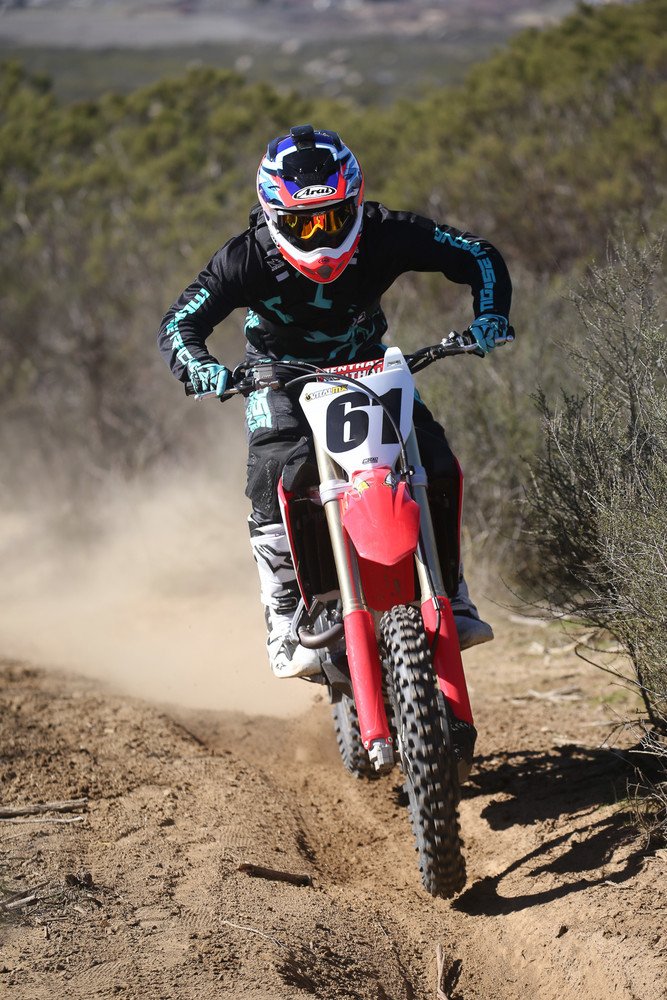
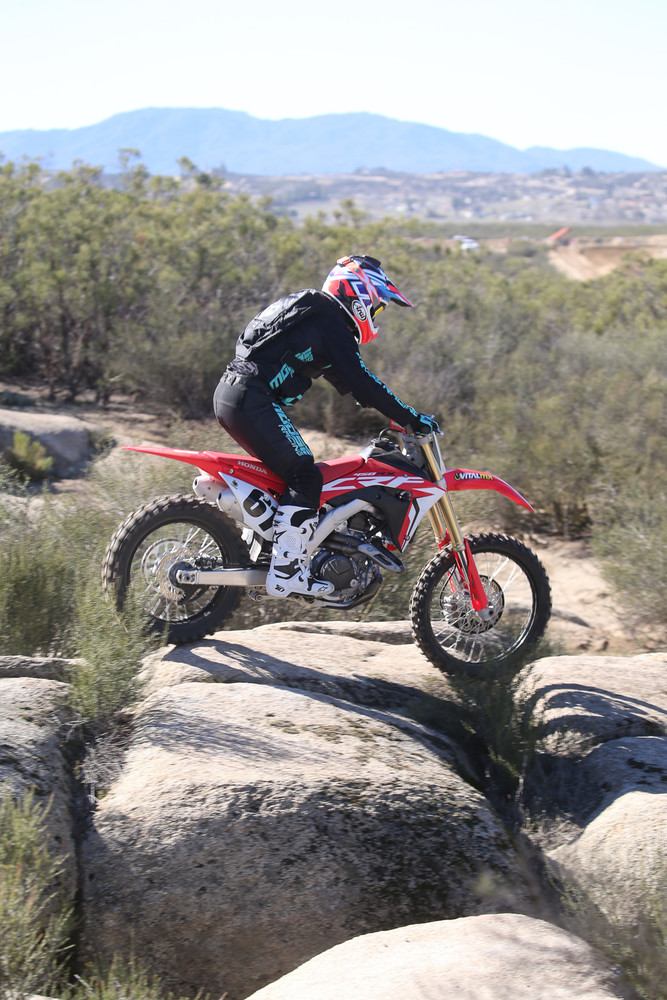
My complaints from the Honda come from the extremely stiff feeling clutch. By far it is the stiffest clutch of the group, yes, it’s one of two cable clutches, but the Yamaha’s cable clutch feels almost hydraulic like. Whereas some of the bikes hide their size or weight while riding, the Honda’s is almost always present. In addition, the Honda has the highest sitting gas tank of the bunch. When the tank is full, it offsets the front/rear weight bias more than any other bike, and because the tank sits rather high, it only adds to the bikes heavy feel while riding and trying to throw it around. The Honda is GP weapon. This bike awards a rider that is willing to push its chassis and suspension, in addition it has the motor to back up its race-oriented package.
Scot Gustafson’s Take
This bike corners razor sharp, the best in class. For a front end steering guy like me that is good. The razor sharp steering did come with a trade off in stability. The 450RX is great on tight courses but would not be my choice for open desert. I set the sag at 108mm to get a good compromise of cornering and stability. The bike feels balanced but you can tell there is some front end bias.

The Showa suspension had a firm feel and worked better in loamy dirt and sand than on hard pack. The RX feels a little heavy compared to the KTM/Husky although some of that feeling disappears when you are riding. The faster you pushed the RX the better it performed. On the motocross track the RX was my 2nd favorite behind the Yamaha FX. Except for the weight, the setting there felt good as a vet motocross bike. The Honda RX has the strongest feeling engine in the class. On our flatish test course the close ratio tranny worked well. Honda added extra tooth on the rear sprocket compared to the R making the shift from 2nd to 3rd better. I switched the handlebar mounted ignition map from the softest on trails to the standard map on the motocross track.
Mystery Guest Tester
The CRF450RX offers an extremely lively and powerful engine that seems to produce massive amounts of power throughout the entire powerband. With a strong hit on the bottom that pulls all the way through the over rev, the Honda seems to be the fastest bike in the class. In addition, RX’s throttle response is extremely snappy and responsive which requires precise rider input.
Honda’s CRF450RX comes strapped with a Showa 49mm coil-spring fork and Showa Pro-Link shock. The RX’s suspension is by far my biggest struggle with the bike. Feeling extremely stiff and rigid, I was never able to get the bike to properly fall into the stroke and provide rider comfort. In the tight single track or rocky sections, the fork seemed to deflect and little more than I would have liked it too. As the trail opened up into faster sections with whoops I figured I would get a little more movement out of the fork, however, it felt harsh on big hits and ultimately beat me up.

The RX’s chassis felt stiff and rigid, and not very compliant. Another issue I had was the front of the bike from the cockpit seemed large and bulky due to its wide gas tank and radiator shrouds. The place where I found myself most comfortable on the RX was skimming the whoops on the motocross track as well as down siding jumps where I felt I was able to use a little more of the suspension.
5. Sherco 450 SCF
Michael Lindsay’s Take
This was my first time riding a Sherco and it was quite surprising. There were some negatives that I expected but some real positives. While every other bike in the test had an overall similar feel, the Sherco is in its own world for seat feel and taper, grips, bar bends, bar mount position, control feel, etc. All these together make the Sherco have the largest adaptation period in the group.

Honestly, the Sherco didn't land in last because it's a bad bike. If we were talking about Enduro or tight, technical trail riding alone, it would've done pretty good. Mix in some moto, Grand Prix, fast single track and desert style riding, then it fell down the order. Really, the Sherco feels more like an enduro race bike then a cross country bike like the rest of the class. Suspension wise, the Sherco is a bit soft and springy feeling. It is well planted and comfortable, but doesn't stay settled in ruts and it was easy to push the suspension beyond its means in higher speed sections or on the moto track. The Sherco isn't the most adept at railing long ruts but it is extremely easy to dab and pivot, regardless of the surface.
With the standard map and the baffle in the exhaust, the Sherco feels more like a dual sport bike than a race machine but this bike probably has the most effective map switch I've ever experienced. With just that flip of the switch, the bike is much more free and lively, along with more connected torque feel. The engine itself is quite torquey and loves to be short shifted. In the more aggressive map and baffle removed, it honestly feels very competitive for the first half to two-thirds of the RPM range. It has a decently connected feel initially, and is fun to creep through the tight stuff and loft the front over obstacle. On the track however, it tends to cut out and lag on landings or tough hits. I found myself revving the bike a bit before I landed to keep it from cutting as hard.

The Sherco is pretty cool to drool over and has a unique look. It has a niche, which screams enduro, creeping around tight trees, playing in rocks, and cutting under lines you didn't think you could. Where it's not at home is a moto track, GP loop, or desert sections. The Sherco doesn't give me much confidence at high speed as the front isn't that stable overall. The KYB suspension is easy to adjust and the bike comes with some pretty cool accessories overall. The Sherco only fit into the Enduro, GNCC, or trail riding segments for me as I wouldn't personally choose it beyond those.
Sean Klinger’s Take
We all said, “remember back when KTMs felt weird and super Euro?” Yeah, that’s how the Sherco feels. There are two maps on the Sherco and they probably have the biggest gap between them than any bike I’ve ridden. With the toggle to the left, it felt pretty good and close to the other bikes, with the toggle to the right, it was like a 350cc bike. The “right” map would only be useful for crazy slick, goopy, moss-covered-rocks-in-the-rain type of riding. Even in map one, the engine is pretty retro feeling. It makes most of its power from the middle of the bottom to the mid-range, then promptly signs off. The very bottom is smooth and torquey but in a mild, slow-revving way. Then in the mid-range it picks up, but if you are a revver, then you’ll be super disappointed because it just starts making more noise than power after the mid. With a six speed transmission and low first and second gear, I barely touched the clutch in the single-track trails.

The KYB fork and shock have a great, smooth action and was very plush. I was pleasantly surprised on the overall feel of the suspension. That being said… It is super soft. This does make it exceedingly comfortable to ride at a mellow pace and the rockier and chunkier the terrain, the happier I was on the SCF. But when trying to either jump through rollers or lean back and push through them, neither worked great. The shock was actually a little stiffer and overpowered the fork a bit, which makes it hard to get the front end up and on top of trail obstacles.

The chassis also has a lot of flex which was great for some things and not great for others. I actually really liked it at the sand track, way more than I thought I would. The Sherco’s chassis feels like it is the complete opposite of the Honda’s. In the sand, the Sherco’s flex was predictable and let me just sort of go with the flow. But on some hard pack trails, when going through repeated hits, sometimes the flex would soak things up favorably, but other times it would step out unexpectedly or the suspension would unload in a weird way.
Chris Hay’s Take
Off-road 85% - Motocross track 15%
Sherco, well where do I begin... First of all I’ve never had the opportunity to swing my leg over a Sherco before but I have seen their success in the World Enduro Championship so I knew the bike had an exotic, yet successful caliber. Jumping onto the bike the cockpit and seating area felt kind of tall and almost like you were sitting on top of the bike rather than in it, not that it’s a bad thing however just a different feeling. Upon starting off in the trails I immediately noticed that it felt a little underpowered compared to the others in the shootout, however this wasn’t a bad thing in the tighter, rocky, slow speed sections where it maneuvered easily.

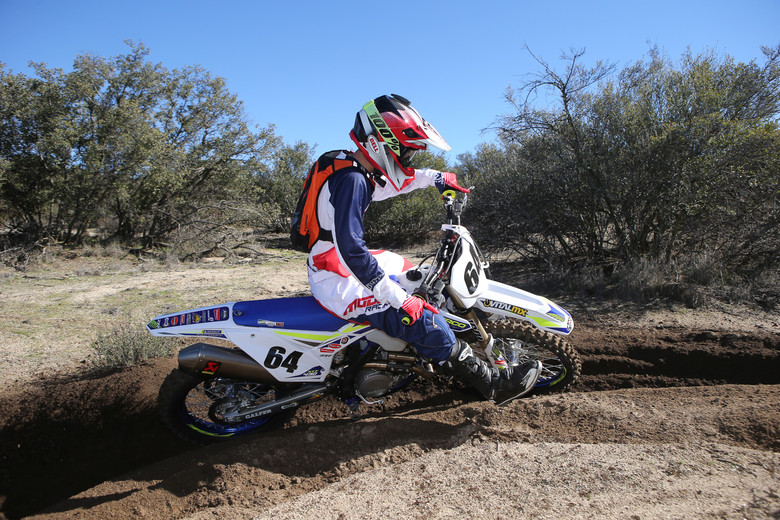
On higher speed trails and the motocross track where the bike struggled the most, it felt like the KYB suspension wasn’t as balanced as the other bikes in the class. The chassis flex under load makes it more unpredictable and doesn’t inspire confidence to keep pushing for a longer period of time. I had to take more risks with less comfort to match the speed of some of the other bikes. Overall the Sherco isn’t a bad bike, but it depends on what kind of riding you were aiming to do. Taking the LITPro data into account and all elusive lap-times, the bike was competitive, but it also felt more risky to go fast on than the others.
Chris Siebenhaar’s Take
In the right environment, I believe the Sherco is amazing. The 450 SCF was at the top of my list in our enduro and trail segment of our test. Overall seat height of the bike felt a bit lower, I found this very nice on flat switchbacks where flicking the bike right to left, could be done with tremendous confidence because the bike felt rather low and planted to the ground.

With the quiet insert in the exhaust, the bike had an extremely mellow and dare I say lethargic power delivery off the bottom. Riding the bike in the “soft” map was almost hard to do because there was hardly any hit to lift the front wheel over unexpected obstacles. Day 2 and 3 we removed the quiet insert, now the bike was more on par with the others in terms of exhaust flow and what a difference! Instantly the bike came to life and there was a little more fight breathed back into this French flyer. The engine’s bottom end really came to life (by Sherco standards) and I was able to ride the bike slightly more aggressive knowing I could count on the engine to get me out of a situation.

When in the right environment, the Sherco’s chassis and suspension combination is extremely good… Again, when in the right environment. On single track trails, in the trees, tight switchbacks or running through rock gardens, the Sherco’s supple suspension and forgiving frame make the bike a dream to ride. However, once you start adding some speed into the equation or trying to time sandy rollers, similar to what you would find desert racing, the chassis binds up and releases rather unpredictably.
Scot Gustafson’s Take
The Sherco looks cool, really cool. It reminds me of a GP works bike with fins in the cylinder and head and lots of trick goodies on the rest of the bike. Sitting on the bike the Sherco feels good. Everything is in the right place and it feels fairly slim. On the trail the chassis is a little slower steering than the other bikes. The frame angles feel like a 2008 Honda frame only in steel. Suspension is KYB like the Yamaha only a bit softer. The Sherco feels like it rides a little lower in the stroke than the other bikes. Where the KTM/Husky suspension was plush and the Japanese bikes were firm the Sherco was in the middle.
An Akropovic exhaust comes stock on the Sherco. It is typical Euro, very large and quiet. It does a great job of muffling sound but it muffles power too. The engine is probably on par with the KTM with the quiet core removed. The engine has 2 map curves. The lessor of the 2 maps is said to cut 7 hp from the motor and would only be used in extreme slippery conditions. The standard map is more "Enduro like" than the other bikes in the test. We had troubles with the bike boiling gas in our test in average riding conditions. Luckily, there is a programmable Trail Tech fan to cool things off. The Sherco was a good bike, it's just the others were better.

Mystery Guest Tester
Although I placed the Sherco last, I did enjoy riding the SEF. The Sherco looks great and offers a cool, euro feel, however, the reason I placed it last comes down to its lack of power and unbalanced suspension. In the engine department, the Sherco felt underpowered and lacking character. When riding the through the whoops I struggled to find the meat of the power to allow me to drive off the face of each single. As I worked my way through corners I found myself needing to use lots of clutch modulation to slide the rear and drive through the sand.
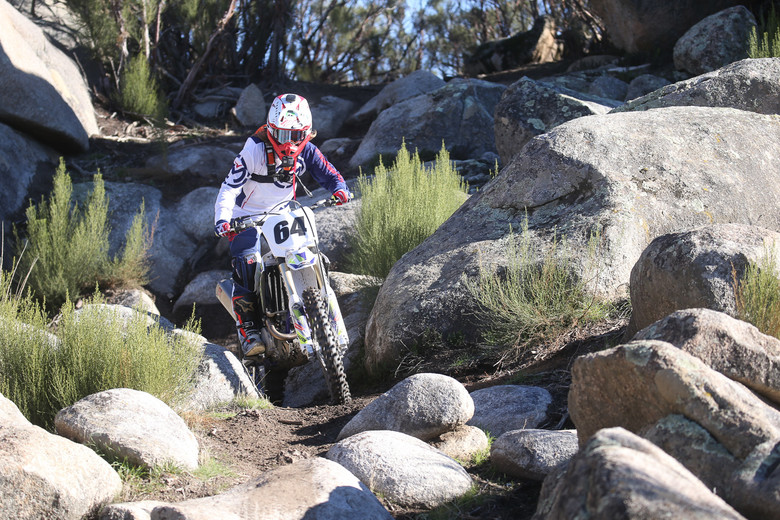
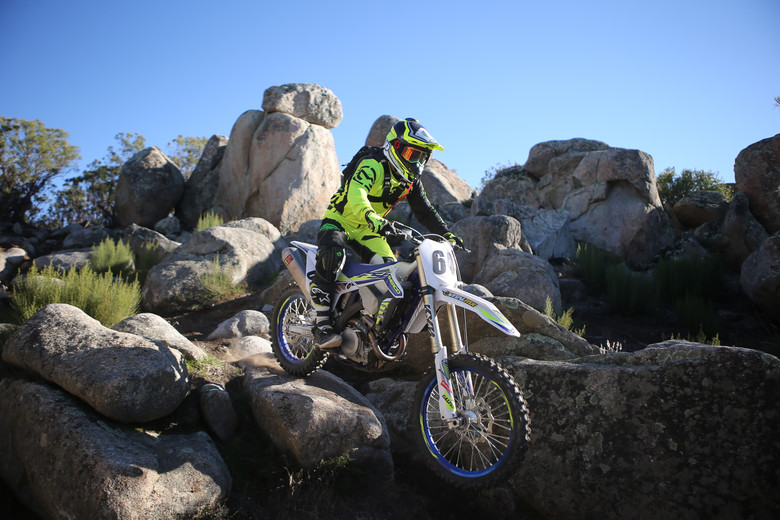
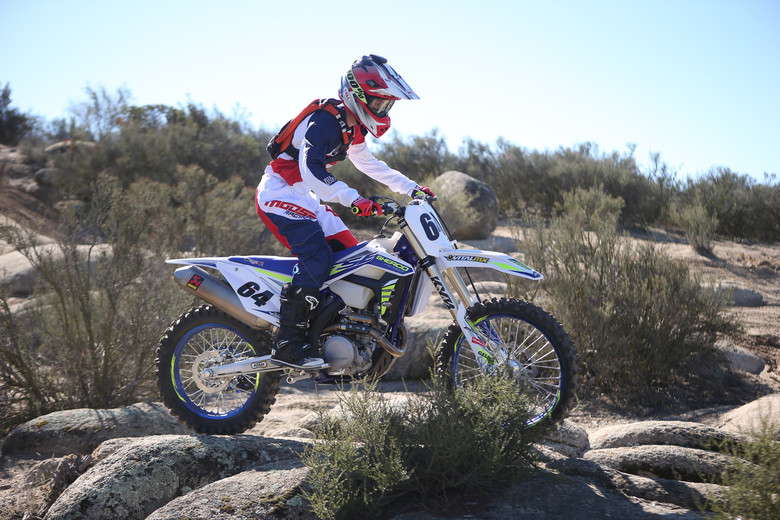
Surprisingly, I found myself out of balance with the KYB suspension on the Sherco for the fork and shock never seemed to work in sync together to provide the comfort I was looking for in the faster sections. As the trail became tighter, I didn't find myself struggling with the suspension as much as I did in the faster, rougher sections. The Sherco offered a light and flickable chassis that was easily maneuverable. Its slim build gave me lots of confidence to put the bike where I wanted it, which proved to be rider friendly. One issue I had was a lack of front end feel in the sand aboard the Sherco which caused me to push the front in certain corners. At the end of the day, I enjoyed the bike but there was nothing that really jumped out at me to elevate this bike in the ranking.
Conclusion
As you can see, there is a wide spread of opinions about these bikes. Partly, this has to do with having six different riders with different experiences and preferences. But this also because these machines are more different from one another because of all the variables involved in making an off-road race bike. With a motocross bike, the bikes tend to be very close performance wise, with just a few personality traits to seperate them. But with cross country bikes, the manufacturers have more room to experiment and decide for themselves what makes a good XC bike.
If you are a desert or GP racer who likes to hit the motocross track a couple times a month, the Honda is the bike for you. It is basically a motocross bike with a bigger tank, kick stand, and 18 inch rear wheel.
The Yamaha is next on the spectrum from full-moto to full-trail riding. It still has an overall motocross-like feel, but it has softer suspension than the Honda and a dedicated wide ratio transmission to handle a larger variety of speeds.
Right in the middle is the KTM which is why it won. It isn’t the best bike on the track, and it isn’t the best bike in tight technical terrain. It is good at both and everything in between, therefore it gets covers the most bases and pleases the widest range of riders.
They Husqvarna is similar to the KTM but his more mellow in all regards, making it a better choice for trail riding and not as much time at the motocross track. Albeit, you can still have plenty of fun at higher speeds on th FX, as one of our testers put down his fastest lap time at Milestone on the Husky.
Lastly on the scale of moto to off-road, the Sherco is firmly at the off-road end of the spectrum. The chassis has some unique flex characteristics and we are curious to see how the SCF would ride with stiffer springs in the suspension and a revalve. Would it be better than any of the other bikes in the test? We aren’t sure. But if you are buying a Sherco, and spending the extra money for it, then you probably know exactly what you want and don’t plan on trying to make it a different bike.
















View replies to: 2019 Vital MX 450 XC Bike Shootout
Comments